SCHEME OF WORK
WEEK TOPIC
1. Revision of last term; work.
2. Martial Arts---- Judo: (a) history of judo in Nigeria. (b) Importance of judo. (c) Skills in judo. (d) Rules, regulations and techniques in judo.
3. Martial Arts----- karate: (a) history of karate and development of karate in Nigeria. (b) Importance of karate. (c) Rules and regulations of karate. (d) Karate skills.
4. Swimming: (a) breast stroke and butterfly strokes. (b) Breast stroke and butterfly stroke skills. (c) History of various life saving strokes.
5. Non-communicable Diseases: (a) meaning of non-communicable diseases. (b) Nature of asthma (ii) ache (iii) cancer (iv) hypertension (v) strokes (vi) diabetes (vii) obesity (viii) rickets (ix) sickle cell (x) boils (xi) anemia (xii) marasmus (xiii) dental carries (xiv) otitis media (xv) kwashiorkor. (c) Prevention measures against non-communicable diseases.
6. Human Trafficking: (a) meaning of human trafficking. (b) Groups of human trafficking victims. (c) Health implications of human trafficking. (d) Solution of human trafficking.
7. Sports laws: (a) Definitions of terms – tort, negligence, legal liability, assault in sports.
8. Sports and society: (a) values/functions of sport in the society – co-operation, leadership, unity crowd control, tension. (b) Management – (i) controlling youth restiveness through sports (ii) crime (iii) drug abuse through sports.
9. Definition of career and branches of physical and health education: (a) definition of career (b) branches of physical and health education –(i) health education (ii) physical education (iii) sports management/administration (iv) sports medicine (v) exercise and sports science (vi) sports marketing (vii) recreational management (viii) sports sociology (ix) safety education (b) how to choose a career.
10. Revision.
3RD TERM
WEEK 1
LESSON 1
TOPIC: MARTIAL ARTS --- JUDO.
CONTENT:
History of judo in Nigeria and Importance of judo
Skills in judo and Techniques in judo
Rules and regulations in judo
MARTIAL ART
Martial Arts, various kinds of fighting arts, with or without weapons, most of which originated in East Asia. Martial arts are now practiced throughout the world.
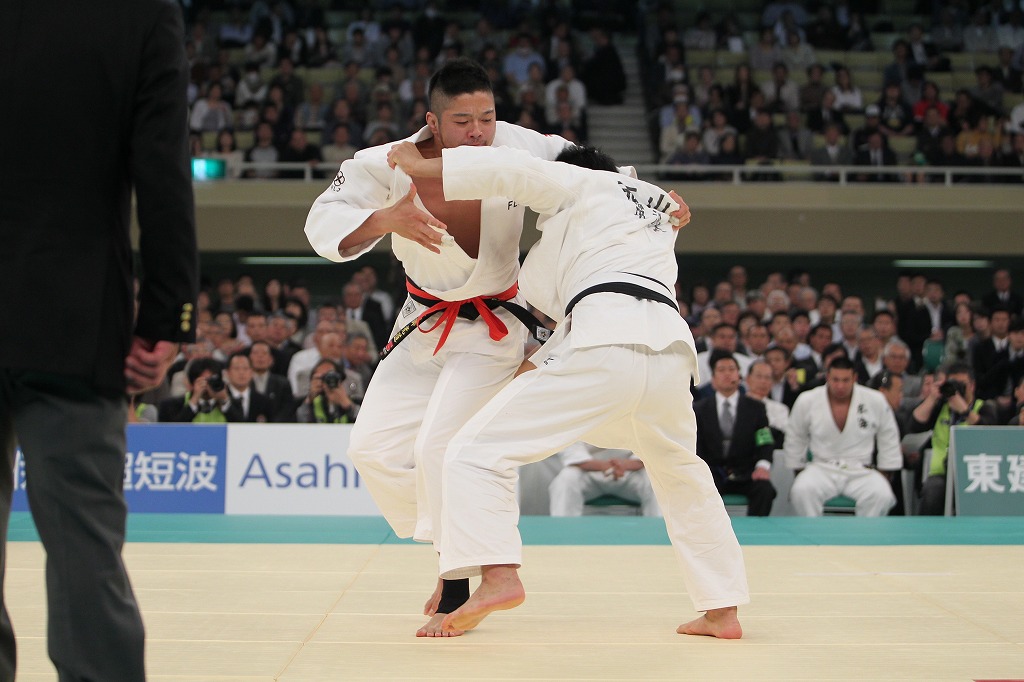
History of judo in Nigeria
Judo martial in which two opponents use movement balance and leverage to gain advantage over each other, was adapted from a traditional Japanese martial art known as jujutsu. Judo a combative game founded by a Japanese jigoro Kano in 1878 is an ethical refinement of jujitsu an oriented martial art.
Judo became an Olympic sport in 1964 when the game held in Tokyo Japan, judo first got official support in Nigeria in 1972 during the preparation for the 22nd all African Games. In line with the national sport commission and Nigeria Amateur Judo Association (NAJA) toward advancement of judo in Nigeria, a British trained judoka in person of Mr. Alexandra E. Ifidon was appointed sport commissioner in Nigeria in 1973. The Nigeria Amateur judo Association (NAJA) was later named Nigeria judo Federation in 1993.
Today the judo federation is widely accepted in all 36 states including the FCT, the first president of the federation was MR S.T Barrow (1972-1994) but the current president is Dr Orji Uzor Kalu.

IMPORTANCE OF JUDO
1. The practice of judo can help build a nation health wise, a good example is china and Japan.
2. Judo Equip an individual with full knowledge and techniques of defense against hijackers.
3. Judo Help build confidence level, courage and encourage us to be energetic in the job sector.
4. Judo is void violent abuse and it is not a game of extortion.
5. Judo Help in the development of speed and free movement of the body.
6. By participating in judo, we could wipe stress and live a healthy life.
https://youtu.be/VrXhVTHoS9g
EVALUATION:
1 Which year did judo became an Olympic sport?
2mention three (3) importance of judo
LESSON 2
SKILLS IN JUDO AND TECHNIQUES IN JUDO
The following are skills in judo
1. Stance
2. Gripping
3. Movement
4. Falling
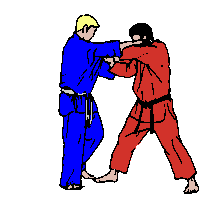
Techniques in judo
• Nage – waza (standing and throwing)
• Katama – waza (grapping)
• Atame – waza (striking)
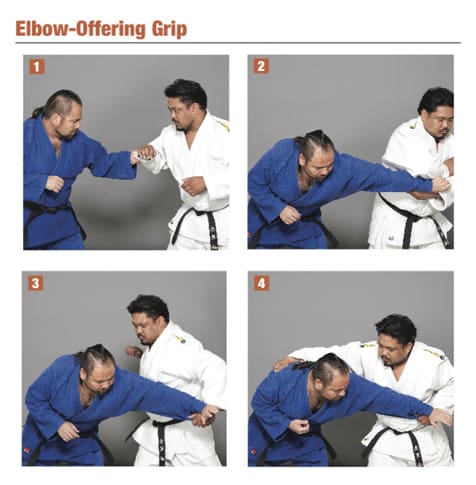
At the beginning and the end of each bout, the two judoka must bow to each other.
A judo match takes between 3 to 10 minutes duration.
Punching or putting head foot leg or arm on an opponent face is prohibited
Refusing to attack or not showing enough aggression can result into penalty.
Judoka must not make a derogatory remarks or gestures to their opponents.
Judoka must be clean and have dry skin and short nails on both feet and hands.
Deliberate going to the floor can warrant a penalty.
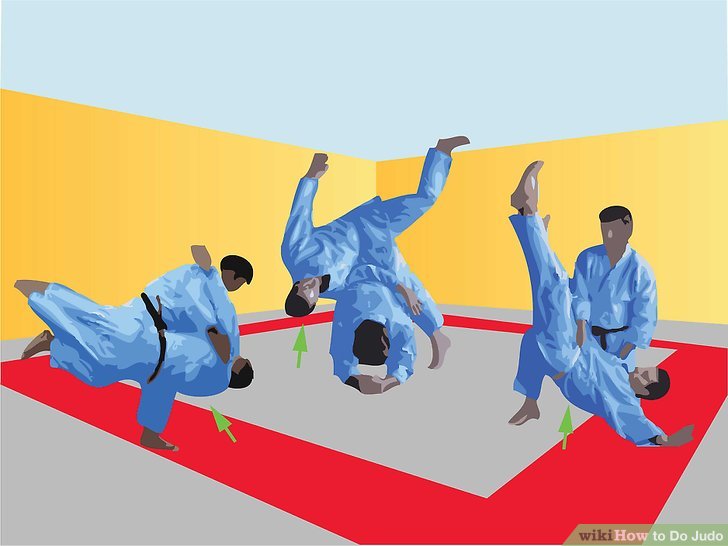
https://youtu.be/UbqkgjmSGg0
EVALUATION:
1. list three skills of judo.
2. Enumerate 4 rules and regulations in Judo
READING ASSIGNMENT: essential of PHE by SA Erazmus book 2 page 93-96.
ASSIGNMENT:
1. judo got official support in Nigeria in which year?
2. mention two (2) techniques in judo
TOPIC: MARTIAL ARTS --- JUDO.
CONTENT:
History of judo in Nigeria and Importance of judo
Skills in judo and Techniques in judo
Rules and regulations in judo
MARTIAL ART
Martial Arts, various kinds of fighting arts, with or without weapons, most of which originated in East Asia. Martial arts are now practiced throughout the world.

History of judo in Nigeria
Judo martial in which two opponents use movement balance and leverage to gain advantage over each other, was adapted from a traditional Japanese martial art known as jujutsu. Judo a combative game founded by a Japanese jigoro Kano in 1878 is an ethical refinement of jujitsu an oriented martial art.
Judo became an Olympic sport in 1964 when the game held in Tokyo Japan, judo first got official support in Nigeria in 1972 during the preparation for the 22nd all African Games. In line with the national sport commission and Nigeria Amateur Judo Association (NAJA) toward advancement of judo in Nigeria, a British trained judoka in person of Mr. Alexandra E. Ifidon was appointed sport commissioner in Nigeria in 1973. The Nigeria Amateur judo Association (NAJA) was later named Nigeria judo Federation in 1993.
Today the judo federation is widely accepted in all 36 states including the FCT, the first president of the federation was MR S.T Barrow (1972-1994) but the current president is Dr Orji Uzor Kalu.

IMPORTANCE OF JUDO
1. The practice of judo can help build a nation health wise, a good example is china and Japan.
2. Judo Equip an individual with full knowledge and techniques of defense against hijackers.
3. Judo Help build confidence level, courage and encourage us to be energetic in the job sector.
4. Judo is void violent abuse and it is not a game of extortion.
5. Judo Help in the development of speed and free movement of the body.
6. By participating in judo, we could wipe stress and live a healthy life.
https://youtu.be/VrXhVTHoS9g
EVALUATION:
1 Which year did judo became an Olympic sport?
2mention three (3) importance of judo
LESSON 2
SKILLS IN JUDO AND TECHNIQUES IN JUDO
The following are skills in judo
1. Stance
2. Gripping
3. Movement
4. Falling

Techniques in judo
• Nage – waza (standing and throwing)
• Katama – waza (grapping)
• Atame – waza (striking)

At the beginning and the end of each bout, the two judoka must bow to each other.
A judo match takes between 3 to 10 minutes duration.
Punching or putting head foot leg or arm on an opponent face is prohibited
Refusing to attack or not showing enough aggression can result into penalty.
Judoka must not make a derogatory remarks or gestures to their opponents.
Judoka must be clean and have dry skin and short nails on both feet and hands.
Deliberate going to the floor can warrant a penalty.

https://youtu.be/UbqkgjmSGg0
EVALUATION:
1. list three skills of judo.
2. Enumerate 4 rules and regulations in Judo
READING ASSIGNMENT: essential of PHE by SA Erazmus book 2 page 93-96.
ASSIGNMENT:
1. judo got official support in Nigeria in which year?
2. mention two (2) techniques in judo
WEEK 2
LESSON 3
TOPIC: Martial Arts – karate
Contents:
History and development of karate in Nigeria
Importance of karate
Rules and regulation of karate
Karate skills
HISTORY AND DEVELOPMENT OF KARATE IN NIGERIA
Karate - do was developed in Okinawa about 500 years ago by Buddists Monks. It was then called Okinawa-te and it was purely meant to train the mind and the body to develop a clear conscience enabling one to face the world truthfully, while externally developing strength and technique until one may be able to overcome even ferocious wild animal (Funakoshi 1973).
Karate-do has since Develop tremendously into an offensive and defensive martial art which one can defeat enemies with a single fist attack or kick without weapons. It is said that one who master karate-do can perform remarkable feast such as breaking several thick board or block with his fist, crushing a green bamboo stalk with his bare hand piecing the flank of a horse with his sword hand and kill a bull with a single stroke of his sword hand.
Over the year and in recent times karate-do has Develop into sport, and it has spread into almost all parts of the world. So well accepted is karate sport that WKF (World Karate Federation) has applied for it to become an Olympic Games Sport which has over 20 medals at stake.
Officially karate sport was established in Nigeria about 10 years ago and it has continued to develop in leaps and bounds. Karate federation of Nigeria is currently affiliated to world karate federation (WKF) and the Union of African karate Federation (UFAK), Nigeria karate are doing well in the continent of Africa and they also hope to make Nigeria proud by winning medals when karate finally features in the Olympic Games.

IMPORTANCE OF KARATE
1. Helps in the development of speed and free movement of the body
2. Karate is a sport that comprises both physical exercise as well as self defense
3. Physicians use karate as a form of treatment for patients
4. Karate is void violent abuse and it is not a game extortion
5. Karate help in movement of our limps that helps regulate proper blood flow in muscles
6. Karate equips an individual with knowledge and techniques of defense against hijackers
7. Karate helps mould one to be discipline and sincere in every sphere of the practical

RULES AND REGULATIONS OF KARATE
A. Avoid deceit and dogmatism
B. Try to see yourself as you truly are
C. Try to adopt what is meritorious in the work of others
D. Abide by the rules and ethic in your daily life weather in public or private
E. Your opponent must always be present in your mind
F. Do not train as doing your techniques as in learning how to dance
G. Train with both Hearth and soul without worrying about theory.
https://youtu.be/LMUBuufENqY
https://youtu.be/DZJQ4PBHIZc
SKILLS IN KARATES
The following are skills in karate:
Atemi-waza (striking)
Naga-waza (throwing or takedowns)
Kansetsu-waza (joint-lock and manipulation
Shime- waza (choking)
Ne-waza (ground fighting and submission)
Usage of human pressure points (especially pressure points strikes)
https://youtu.be/u2bPmcN-vSQ
EVALUATION:
1. Mention three (3) importance of karate
2. Identify three rules and regulations of karate
3. What is the full meaning of WKF
READING ASSIGNMENT: Essential of PHE by SA Erazmus book 2 page 97—98.
ASSIGNMENT:
1.
2. identify five (5) skills in karate
TOPIC: Martial Arts – karate
Contents:
History and development of karate in Nigeria
Importance of karate
Rules and regulation of karate
Karate skills
HISTORY AND DEVELOPMENT OF KARATE IN NIGERIA
Karate - do was developed in Okinawa about 500 years ago by Buddists Monks. It was then called Okinawa-te and it was purely meant to train the mind and the body to develop a clear conscience enabling one to face the world truthfully, while externally developing strength and technique until one may be able to overcome even ferocious wild animal (Funakoshi 1973).
Karate-do has since Develop tremendously into an offensive and defensive martial art which one can defeat enemies with a single fist attack or kick without weapons. It is said that one who master karate-do can perform remarkable feast such as breaking several thick board or block with his fist, crushing a green bamboo stalk with his bare hand piecing the flank of a horse with his sword hand and kill a bull with a single stroke of his sword hand.
Over the year and in recent times karate-do has Develop into sport, and it has spread into almost all parts of the world. So well accepted is karate sport that WKF (World Karate Federation) has applied for it to become an Olympic Games Sport which has over 20 medals at stake.
Officially karate sport was established in Nigeria about 10 years ago and it has continued to develop in leaps and bounds. Karate federation of Nigeria is currently affiliated to world karate federation (WKF) and the Union of African karate Federation (UFAK), Nigeria karate are doing well in the continent of Africa and they also hope to make Nigeria proud by winning medals when karate finally features in the Olympic Games.

IMPORTANCE OF KARATE
1. Helps in the development of speed and free movement of the body
2. Karate is a sport that comprises both physical exercise as well as self defense
3. Physicians use karate as a form of treatment for patients
4. Karate is void violent abuse and it is not a game extortion
5. Karate help in movement of our limps that helps regulate proper blood flow in muscles
6. Karate equips an individual with knowledge and techniques of defense against hijackers
7. Karate helps mould one to be discipline and sincere in every sphere of the practical

RULES AND REGULATIONS OF KARATE
A. Avoid deceit and dogmatism
B. Try to see yourself as you truly are
C. Try to adopt what is meritorious in the work of others
D. Abide by the rules and ethic in your daily life weather in public or private
E. Your opponent must always be present in your mind
F. Do not train as doing your techniques as in learning how to dance
G. Train with both Hearth and soul without worrying about theory.
https://youtu.be/LMUBuufENqY
https://youtu.be/DZJQ4PBHIZc
SKILLS IN KARATES
The following are skills in karate:
Atemi-waza (striking)
Naga-waza (throwing or takedowns)
Kansetsu-waza (joint-lock and manipulation
Shime- waza (choking)
Ne-waza (ground fighting and submission)
Usage of human pressure points (especially pressure points strikes)
https://youtu.be/u2bPmcN-vSQ
EVALUATION:
1. Mention three (3) importance of karate
2. Identify three rules and regulations of karate
3. What is the full meaning of WKF
READING ASSIGNMENT: Essential of PHE by SA Erazmus book 2 page 97—98.
ASSIGNMENT:
1.
2. identify five (5) skills in karate
WEEK 3
LESSON 4
TOPIC: SWIMMING
Contents:
Meaning of swimming
Strokes in swimming
History of various life saving strokes
MEANING OF SWIMMING
Swimming, act of moving through the water by using the arms, legs, and body in motions called strokes. The most common strokes are the crawl, backstroke, breaststroke, butterfly, and sidestroke. Swimming is an integral part of almost all water-based activities. It is also a competitive sport itself.
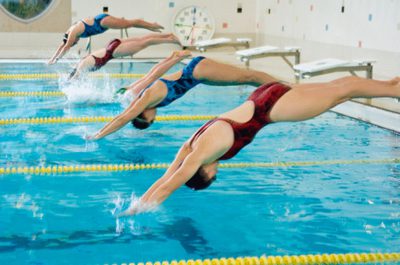
STROKES IN SWIMMING
1. Crawl
2. Backstroke
3. Breaststroke
4. Butterfly
5. Sidestroke
BREAST STROKES SKILLS
This is a swimming stroke in which both arms are extended and pulled back together in a circular motion while both legs are thrust out and pulled back together.
The breaststroke is one of the easiest and most relaxing strokes for novices. Competitive swimmers, however, find it difficult because it uses more energy than the crawl and backstroke when swum at a fast pace. The breaststroke has undergone major changes since it was introduced in the 17th century. Most swimmers now use a technique called the wave breaststroke, which Hungarian coach Jozsef Nagy developed in the late 1980s.
This interactive illustration captures four moments in the breaststroke. The breaststroke is the slowest competitive stroke, and during races the technique of the swimmers is strictly regulated to ensure a fair contest. In this diagram, the swimmer is moving to the right.
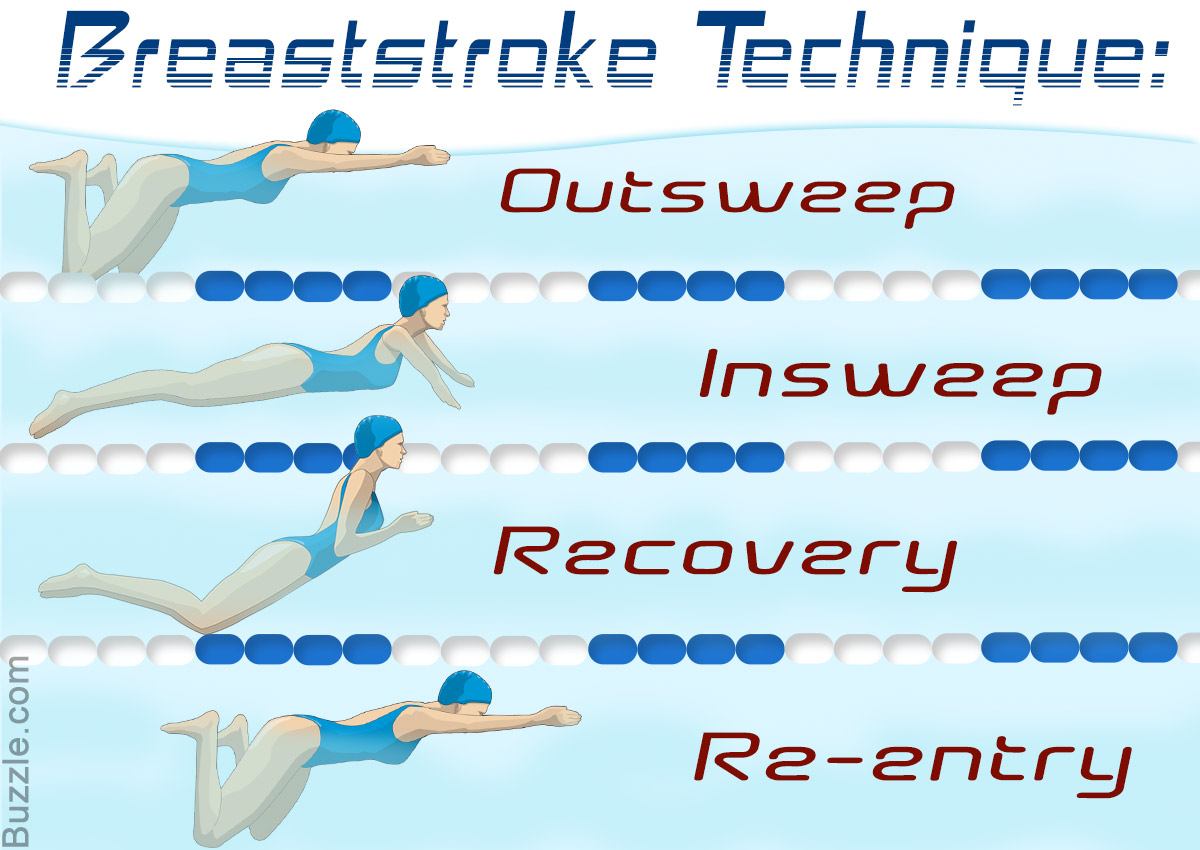
BUTTERFLY STROKE SKILLS
Swimming same as butterfly
In butterfly stroke the arms move together through the water and the feet pump together in what is Known as the dolphin kick.
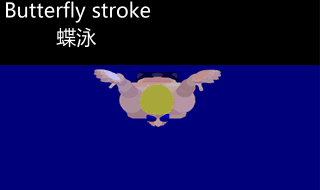
Swimming, act of moving through the water by using the arms, legs, and body in motions called strokes. The most common strokes are the crawl, backstroke, breaststroke, butterfly, and sidestroke. Swimming is an integral part of almost all water-based activities. It is also a competitive sport itself.
Some scientists believe that human beings are born with an instinctive ability to use their arms and legs to stay afloat. That instinct, however, disappears within a few months after birth. Later in life many children and adults learn to swim in order to be safe around the water, to have fun, and to participate in competition.
II SWIMMING FUNDAMENTALS
People can swim in any body of water large enough to permit free movement. These areas include ponds, lakes, rivers, the ocean, and pools. Most people enjoy swimming in water that is between 18° and 29°C (64° and 84°F).
A Learning to Swim
In many parts of the world, people learn to swim by imitating others, most often their parents, brothers, sisters, and friends. Most youngsters in North America also take lessons at swim clubs, community centers, schools, or recreational facilities. In addition, the American Swimming Coaches Association (ASCA) and the American Red Cross sponsor programs that teach children about water safety.
Instructors teach students skills that will make them safe, efficient, and confident swimmers. Beginners first put their heads in the water and blow bubbles by exhaling. Gradually, students progress to floating, treading water, and ultimately, learning the techniques of the major strokes.
Students use various pieces of equipment during these lessons. Water-wings are inflatable worn around the upper arms; they allow children to float easily. Kickboards are buoyant boards that students can rest their arms on; this keeps their upper bodies afloat and allows them to concentrate on kicking correctly. Pull-buoys are foam floats that swimmers hold between their thighs to keep the lower body high and flat on the surface of water; using them, students can learn the arm and upper sbody movements of various strokes. Paddles are small, firm boards fitted over the hands; they force students to pull their arms through the water correctly. Fins worn on the feet allow swimmers to go faster and to develop proper body position and power.
https://youtu.be/xNPZ4JunHJo
B Hazards and Safety Measures
Individuals should not swim in conditions that their ability and experience will not allow them to handle. For inexperienced recreational swimmers, many safety hazards exist—even in a pool. These hazards include misjudging a dive and hitting one’s head on the bottom, holding one’s Breath too long, becoming exhausted, and experiencing sudden cramps while too far from shore or other swimmers.
In rivers and oceans, all swimmers should respect the power of nature. Powerful waves, tides, and currents can easily overpower even the most experienced swimmers, sweeping them out beyond safety or throwing them into coral or rocks. Caves pose additional dangers because swimmers can be trapped inside them. Swimmers must follow the instructions of lifeguards and obey posted information about water conditions, tides, and other dangers such as jellyfish or pollution. A good precaution for children is the buddy system, in which each child is paired with another while in the water. This system ensures that no person is swimming alone and that if an emergency does happen, the lifeguard can be notified immediately.
https://youtu.be/Cu03N8h8J_k
III THE MAJOR STROKES
Four of the five main swimming strokes—the crawl, backstroke, breaststroke, and butterfly—are used both in competition and recreation. The fifth major stroke, the sidestroke, is slower than the competitive strokes and is used primarily as a recreational and life-saving technique.
A Crawl
The crawl is the fastest and most efficient swimming technique. It is also called the freestyle, because swimmers use it in freestyle events, which allow the use of any stroke.
To swim the crawl, a swimmer travels through the water with the chest and head pointing downward toward the bottom. The legs move in a flutter kick, moving up and down quickly and continually. Each arm stroke begins as the right arm is brought in front and slightly to the right of the swimmer’s head and into the water. When the right hand enters the water, the right elbow should be above the surface of the water and the body should be tilted slightly to the left side. At the same time, the left arm accelerates underneath the water in a pulling motion down the length of the body.
After the right arm enters the water, the body naturally rolls to the right so that the body is horizontal to the water surface. The left arm continues through the stroke at the swimmer’s side. The swimmer continues to extend the right arm forward, and the body begins to roll onto its right side.
As the right arm begins to pull the swimmer forward, it increases the body’s tilt to the right side, and the left arm exits the water near the swimmer’s hip.
https://youtu.be/fqTdZlqfrio
The swimmer then brings the left arm forward to enter the water while the right arm travels down the swimmer’s side. As the left arm enters the water and the right arm exits, the swimmer’s body begins to turn to the left side again, and the swimmer begins the stroke sequence once more.
In the crawl, turning the head to breathe is a simple, easy motion that should be coordinated with the body roll. As the body tilts completely to the right or left side, the swimmer should roll the head to the same side and take a breath. After inhaling, the swimmer puts his or her face back in the water, looking toward the bottom of the pool. The swimmer exhales slowly through the nose or mouth as the body rolls toward the other side.
B Backstroke
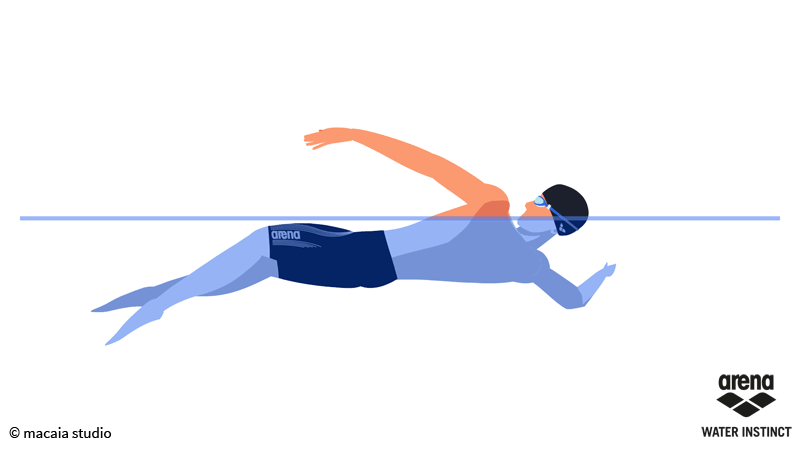
The backstroke is the only stroke that is swum on the back, with the swimmer looking up. Backstroke swimmers therefore cannot see where they are going. Because the face is out of the water, swimmers need no special breathing technique. Back stroke use the same flutter kick that crawl swimmers do.
At the beginning of each arm stroke, the swimmer extends the right arm so it enters the water slightly to the right of the head. The palm should be facing away from the swimmer and the pinky finger should enter the water first. At the same time, the swimmer moves the left arm through the water below the left side of the body. Once in the water, the right arm begins pulling the swimmer forward by bending at the elbow. At the same time the swimmer holds the left arm straight as it reaches the hip and lifts it out of the water. As the right arm continues to pull, the swimmer rotates slightly onto the right side and swings the left arm up above the head.
As the swimmer finishes the right arm’s stroke along the body, he or she begins to rotate toward the left side as the left arm reaches to enter the water above the head.
As the left hand enters the water, the body completes its roll to the left side and the right arm lifts out of the water. Continuing these motions, the swimmer moves forward.
https://youtu.be/rLBxLUF1jiI
C Breaststroke
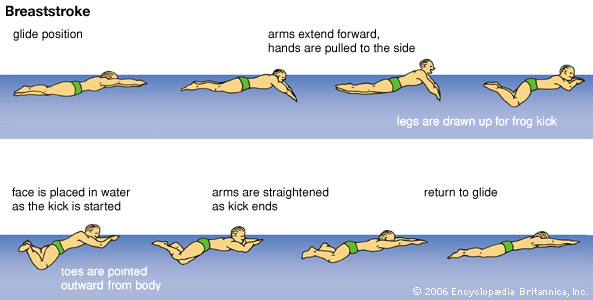
The breaststroke is one of the easiest and most relaxing strokes for novices. Competitive swimmers, however, find it difficult because it uses more energy than the crawl and backstroke when swum at a fast pace. The breaststroke has undergone major changes since it was introduced in the 17th century. Most swimmers now use a technique called the wave breaststroke, which Hungarian coach Jozsef Nagy developed in the late 1980s.
To swim the wave breaststroke, the swimmer enters the water with the body streamlined, facing the pool bottom with arms and legs fully extended. To begin the stroke, the swimmer sweeps the arms out with the hands facing outward and bent slightly upward at the wrist. When the swimmer’s body and arms form a T-shape, the swimmer bends each arm at the elbow.
The elbows remain near the surface of the water, while the forearms and hands, pointing toward the bottom of the pool, sweep inward and underneath the chin. The swimmer shrugs the shoulders, looks down, and arches the back as the arm sweep pulls the body forward. The swimmer then raises the feet to the surface of the water, bends the knees, and spreads the legs. The thighs should remain in line with the body.
As the head and upper torso clear the surface of the water, the swimmer inhales and lunges forward with the arms. During this movement the swimmer turns the feet outward and kicks backward. The swimmer then returns to the basic streamlined position and repeats the stroke.
https://youtu.be/syPEtHsI0J4
D Butterfly
West German swimmer Michael Gross won two gold medals at the 1984 Olympic Games in Los Angeles, California, and another at the 1988 Olympics in Seoul, South Korea. He was nicknamed the Albatross because of his large arm span. He is seen here swimming the 100-meter butterfly during the 1984 Games.
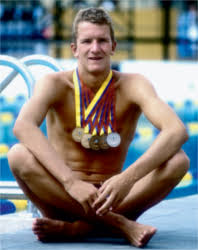
The butterfly stroke is powerful, graceful, and fast. More than any other stroke, the butterfly relies on good technique. Developed between 1930 and 1952, the butterfly is swum with an undulating motion. The arms are brought forward over the water’s surface, then brought back together in front of the body simultaneously. Each arm stroke is complemented by two dolphin kicks, meaning the feet are kept together and brought down then up again, much like the motion of a dolphin’s tail.
The swimmer begins the butterfly with the body in the basic streamlined position and the head facing downward. The arms enter the water with the hands facing outward, as the swimmer lunges forward, submerging the head and chest slightly. At this point the swimmer makes a light downward kick with both feet. The body glides forward, and the hands catch water and begin to pull.
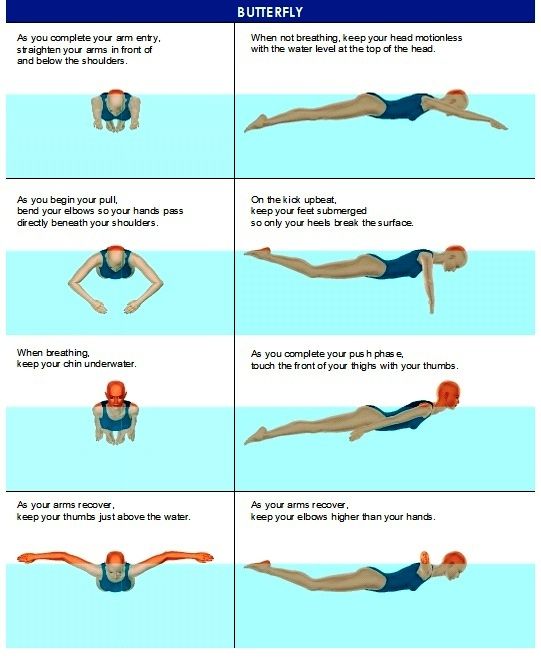
This interactive illustration captures four moments in the butterfly stroke. In the butterfly, the arms move together through the water, and the feet pump together in what is known as the dolphin kick. Swimming the butterfly is tiring, so few swimmers use it except during races. However, the butterfly’s effort does translate into speed, and it is almost as fast as the crawl stroke. In this diagram, the swimmer is moving to the right.
The pulling stroke begins with the hands facing outward and the elbows near the water surface. The swimmer pulls the hands down so that they come together under the body. The legs start the second downward kick.
When the swimmer then pulls the arms down to the hips, the motion forces the head and shoulders above the surface of the water. This positioning enables the swimmer to inhale.
The swimmer finishes the arm pull with a sweeping motion that brings each arm along the sides with the palms facing in. When the second downward kick is completed, the swimmer swings the arms slightly out of the water and glides forward. Another stroke cycle begins as the swimmer plunges the arms back into the water above the head.
https://youtu.be/flqjEUsDn9k
E Sidestroke
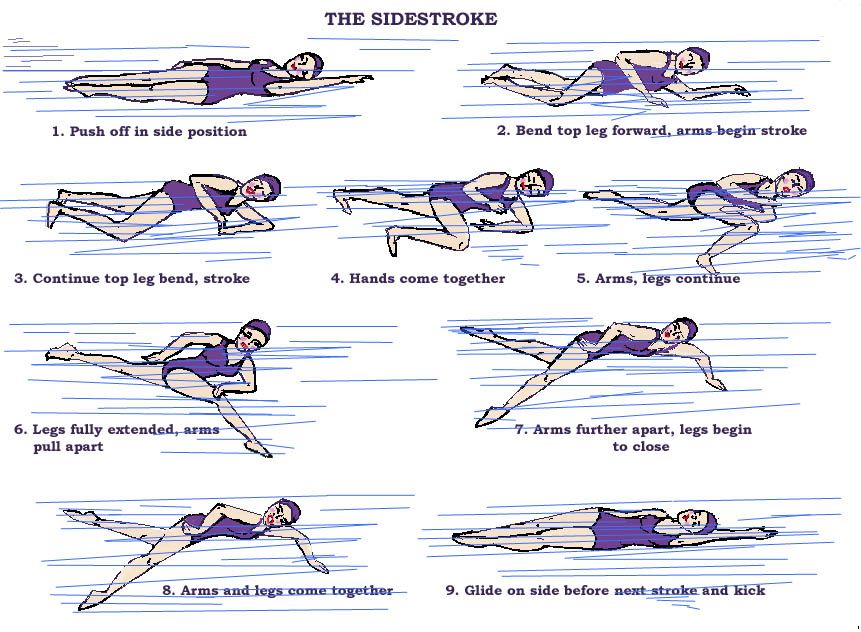
American swimmer Janet Evans raises her arm in triumph after winning the Olympic gold medal in the women’s 400-meter individual medley in 1988. Evans won a total of three gold medals at the 1988 Olympics and she has registered world records for three separate events. Women’s swimming has been an Olympic sport since 1912.
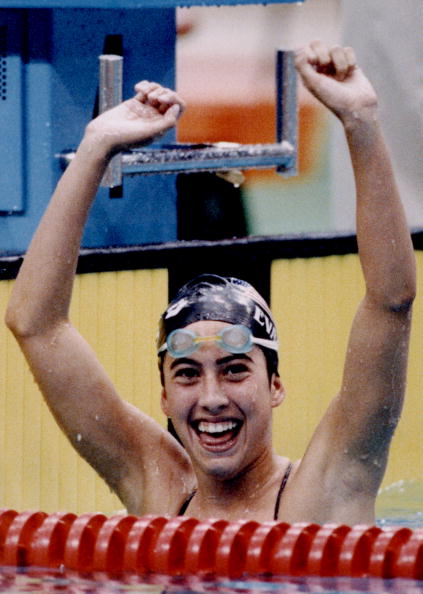
Many regional meets are held every two or four years. These include the Pan-Pacific Championships for nations in Asia and the Pacific Ocean region, the European championships, the Pan American Games for the countries of North and South America, and the African championships.
To participate in international meets, a swimmer must be selected by his or her national federation. Many countries base the selection on performances at national championships or Olympic trials. In addition, swimmers must meet international time standards predetermined by FINA. However, each country is allowed to select one swimmer per event regardless of the swimmer’s times.
https://youtu.be/heKKhNBHp98
LESSON 5
V OTHER SWIMMING ACTIVITIES
Snorkeling
Snorkeling is a popular activity that involves swimming face down in the water while breathing through a slender plastic tube called a snorkel. Most people snorkel as a way to view aquatic plants and animals. Snorkelers use a mask to see the underwater objects and wear fins to propel themselves.
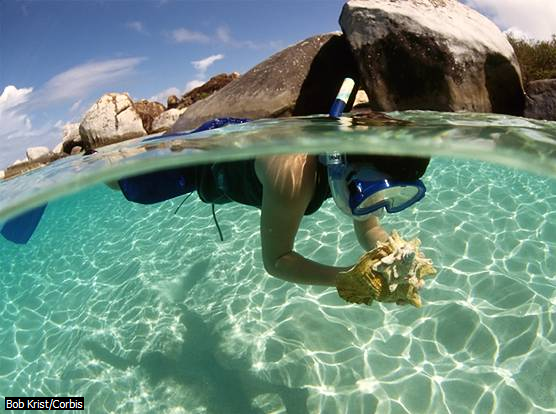
Swimming is integral to several sports, including body boarding, snorkeling, surfing, synchronized swimming, triathlon, underwater diving, and water polo. People also should have strong swimming skills in a variety of other water-based activities, including competitive diving, fishing, jet-skiing, rowing, sailing, and waterskiing.
Swimming is a valuable activity for physical therapy and exercise. Because it works the majority of the muscles in the body and provides both aerobic benefits and resistance benefits (as the swimmer pulls and pushes through the water), the sport is generally considered one of the most complete forms of exercise. Swimming does not strain joints and connective tissue as much as many other forms of exercise, and swimmers injure themselves at a lower rate than most other athletes. Athletes in other sports who are recovering from injuries often swim to stay in shape.
Water Polo
Water polo, a team sport played in swimming pools, became an Olympic sport in 1900. A water polo team, such as the team wearing white caps pictured here, has 35 seconds to score each time it attacks its opponent. Goals are scored by throwing or pushing the ball past the opponent’s floating goalposts.
Several exercise programs are water based. In water aerobics, the water provides extra resistance for cardiovascular workouts. Many older adults exercise by becoming involved in programs with organized coaching, workouts, and competition. Swimming laps in pools is an extremely popular exercise among people of all ages.

Not all competitions take place in pools. In long-distance swimming, racers compete over lengthy courses, usually in lakes, rivers, or the ocean. Most competitions are held at distances of 5 and 25 km (3.1 and 15.5 mi), but some races are longer than 38 km (24 mi). The longest races can take seven or eight hours to complete.
Several occupations require that individuals be proficient swimmers. For lifeguards, swimming skills are perhaps most important because lifeguards are responsible for the safety of other people in swimming areas. Scuba diving and snorkeling instructors also must be prepared to assist others if an emergency occurs. Physical education teachers must swim well enough to teach others. Underwater archaeologists do research while scuba diving, so strong swimming skills help them with their work. Pearl divers must be able to swim deep and hold their breath for a long time as they descend to the bottom to search for their treasures. Sailors and offshore oil workers do not swim as part of their jobs, but because they work on the water, they should be able to swim fairly well in case they accidentally fall overboard.
VI HISTORY
Human beings have been swimming for thousands of years. One of the earliest representations of swimming is an ancient Egyptian wall relief that shows soldiers of Pharaoh Ramses II (reigned 1290-1224 BC) pursuing their enemies by swimming across the Orontes River between ancient Egypt and Asia Minor.
Swimming was highly esteemed in ancient Greece and Rome, especially as a form of training for warriors. In Japan, competitions were held as early as the 1st century BC. In Europe, swimming was less popular during the Middle Ages (5th century to 15th century), when immersion in water was sometimes associated with the recurrent epidemic diseases of the time.
The crawl stroke was probably invented independently in various areas of the world several hundred years ago. Swimmers in South America and the South Pacific used crawl-like strokes long before they were used in Europe. Native Americans also used an over arm crawl stroke. In 1844 two members of the Native American Ojibwa tribe named The Flying Gull and Tobacco travelled to England, where they defeated local champions and became national celebrities.
By the 19th century European misconceptions about the dangers of swimming had been dispelled. In the late 19th century amateur swimming clubs began conducting competitions in the United States and Britain. In the United States, colleges and universities such as Yale University, Indiana University, and the University of Southern California played an important role in spreading interest in swimming as a competitive sport. In 1875 Matthew Webb of Great Britain became the first person to swim across the English Channel (see Channel Swimming). Webb swam between Dover, England, and the coast of France near Calais, where the channel is more than 32 km (20 mi) in width. By 1896 swimming had become well established. It was one of the sports at the first modern Olympic Games, held that year in Athens, Greece.
A Early Champions
At the 1904 Olympics in St. Louis, Missouri, American swimmer Charles Daniels won gold medals in the 200-meter and 400-meter freestyle, signalling the beginning of an era of American dominance that lasted until the 1930s.
Women’s swimming became an Olympic sport at the 1912 Games in Stockholm, Sweden, and Australian swimmer Fanny Durack won the first gold medal in the 100-meter freestyle. That same year American swimmer Duke Kahanamoku won the men’s 100-meter freestyle. Kahanamoku repeated his 100-meter victory at the 1920 Games in Antwerp, Belgium, and was also a member of the winning 4 × 200-meter freestyle relay team. Later, Kahanamoku travelled worldwide as a Red Cross water safety instructor, promoting swimming and the sport of surfing.
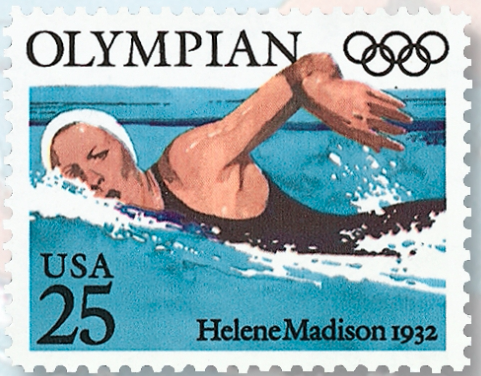

Swimming became more popular in the United States in the 1940s and 1950s, partly due to American swimmer and actor Esther Williams. Because the Olympics were cancelled during World War II (1939-1945), Williams never competed in the Olympics competition, but she starred in a number of popular motion pictures that featured her in water ballets, swimming, diving, and waterskiing. She went on to develop her own line of swimming pools.
In the 1950s and 1960s Australian swimmers enjoyed great Olympic success, including Murray Rose, Jon Konrads, David Thiele, and Dawn Fraser. Fraser became the first Olympic champion to win the same event at three different Olympics when she captured the gold medal in the 100-meter freestyle at the 1956 Games in Melbourne, Australia, the 1960 Games in Rome, Italy, and the 1964 Games in Tokyo, Japan.
B Champions Since the 1970s
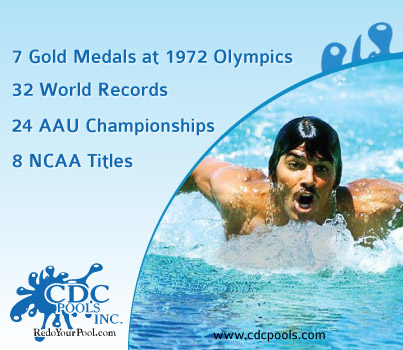
At the 1988 Games in Seoul, South Korea, Kristin Otto of East Germany won six gold medals and Janet Evans of the United States won three. American Matt Biondi won five gold medals in the men’s events. Also at Seoul, Anthony Nesty of Suriname became the first black Olympic swimming champion when he won the 100-meter butterfly.


D Recent Developments

In open water swimming, Australia’s Susie Maroney performed several feats previously thought impossible. In 1997 she became the first person to swim the 169-km (105-mi) strait between Havana, Cuba, and Key West, Florida. The following year she completed a 206-km (128-mi) swim from Isla Mujeres, Mexico, to Las Tumbas beach in Cuba. In 1999 Maroney swam the 160-km (100-mi) distance from Jamaica to Cuba.
EVALUATION:
1. defined swimming
2. mention four strokes in swimming
3. mention three safety precaution during swimming
Reading assignment: Essential of PHE by SA Erazmus book 2 page 99—104
TOPIC: SWIMMING
Contents:
Meaning of swimming
Strokes in swimming
History of various life saving strokes
MEANING OF SWIMMING
Swimming, act of moving through the water by using the arms, legs, and body in motions called strokes. The most common strokes are the crawl, backstroke, breaststroke, butterfly, and sidestroke. Swimming is an integral part of almost all water-based activities. It is also a competitive sport itself.

STROKES IN SWIMMING
1. Crawl
2. Backstroke
3. Breaststroke
4. Butterfly
5. Sidestroke
BREAST STROKES SKILLS
This is a swimming stroke in which both arms are extended and pulled back together in a circular motion while both legs are thrust out and pulled back together.
The breaststroke is one of the easiest and most relaxing strokes for novices. Competitive swimmers, however, find it difficult because it uses more energy than the crawl and backstroke when swum at a fast pace. The breaststroke has undergone major changes since it was introduced in the 17th century. Most swimmers now use a technique called the wave breaststroke, which Hungarian coach Jozsef Nagy developed in the late 1980s.
This interactive illustration captures four moments in the breaststroke. The breaststroke is the slowest competitive stroke, and during races the technique of the swimmers is strictly regulated to ensure a fair contest. In this diagram, the swimmer is moving to the right.

BUTTERFLY STROKE SKILLS
Swimming same as butterfly
In butterfly stroke the arms move together through the water and the feet pump together in what is Known as the dolphin kick.

Swimming, act of moving through the water by using the arms, legs, and body in motions called strokes. The most common strokes are the crawl, backstroke, breaststroke, butterfly, and sidestroke. Swimming is an integral part of almost all water-based activities. It is also a competitive sport itself.
Some scientists believe that human beings are born with an instinctive ability to use their arms and legs to stay afloat. That instinct, however, disappears within a few months after birth. Later in life many children and adults learn to swim in order to be safe around the water, to have fun, and to participate in competition.
II SWIMMING FUNDAMENTALS
People can swim in any body of water large enough to permit free movement. These areas include ponds, lakes, rivers, the ocean, and pools. Most people enjoy swimming in water that is between 18° and 29°C (64° and 84°F).
A Learning to Swim
In many parts of the world, people learn to swim by imitating others, most often their parents, brothers, sisters, and friends. Most youngsters in North America also take lessons at swim clubs, community centers, schools, or recreational facilities. In addition, the American Swimming Coaches Association (ASCA) and the American Red Cross sponsor programs that teach children about water safety.
Instructors teach students skills that will make them safe, efficient, and confident swimmers. Beginners first put their heads in the water and blow bubbles by exhaling. Gradually, students progress to floating, treading water, and ultimately, learning the techniques of the major strokes.
Students use various pieces of equipment during these lessons. Water-wings are inflatable worn around the upper arms; they allow children to float easily. Kickboards are buoyant boards that students can rest their arms on; this keeps their upper bodies afloat and allows them to concentrate on kicking correctly. Pull-buoys are foam floats that swimmers hold between their thighs to keep the lower body high and flat on the surface of water; using them, students can learn the arm and upper sbody movements of various strokes. Paddles are small, firm boards fitted over the hands; they force students to pull their arms through the water correctly. Fins worn on the feet allow swimmers to go faster and to develop proper body position and power.
https://youtu.be/xNPZ4JunHJo
B Hazards and Safety Measures
Individuals should not swim in conditions that their ability and experience will not allow them to handle. For inexperienced recreational swimmers, many safety hazards exist—even in a pool. These hazards include misjudging a dive and hitting one’s head on the bottom, holding one’s Breath too long, becoming exhausted, and experiencing sudden cramps while too far from shore or other swimmers.
In rivers and oceans, all swimmers should respect the power of nature. Powerful waves, tides, and currents can easily overpower even the most experienced swimmers, sweeping them out beyond safety or throwing them into coral or rocks. Caves pose additional dangers because swimmers can be trapped inside them. Swimmers must follow the instructions of lifeguards and obey posted information about water conditions, tides, and other dangers such as jellyfish or pollution. A good precaution for children is the buddy system, in which each child is paired with another while in the water. This system ensures that no person is swimming alone and that if an emergency does happen, the lifeguard can be notified immediately.
https://youtu.be/Cu03N8h8J_k
III THE MAJOR STROKES
Four of the five main swimming strokes—the crawl, backstroke, breaststroke, and butterfly—are used both in competition and recreation. The fifth major stroke, the sidestroke, is slower than the competitive strokes and is used primarily as a recreational and life-saving technique.
A Crawl
The crawl is the fastest and most efficient swimming technique. It is also called the freestyle, because swimmers use it in freestyle events, which allow the use of any stroke.
To swim the crawl, a swimmer travels through the water with the chest and head pointing downward toward the bottom. The legs move in a flutter kick, moving up and down quickly and continually. Each arm stroke begins as the right arm is brought in front and slightly to the right of the swimmer’s head and into the water. When the right hand enters the water, the right elbow should be above the surface of the water and the body should be tilted slightly to the left side. At the same time, the left arm accelerates underneath the water in a pulling motion down the length of the body.
After the right arm enters the water, the body naturally rolls to the right so that the body is horizontal to the water surface. The left arm continues through the stroke at the swimmer’s side. The swimmer continues to extend the right arm forward, and the body begins to roll onto its right side.
As the right arm begins to pull the swimmer forward, it increases the body’s tilt to the right side, and the left arm exits the water near the swimmer’s hip.
https://youtu.be/fqTdZlqfrio
The swimmer then brings the left arm forward to enter the water while the right arm travels down the swimmer’s side. As the left arm enters the water and the right arm exits, the swimmer’s body begins to turn to the left side again, and the swimmer begins the stroke sequence once more.
In the crawl, turning the head to breathe is a simple, easy motion that should be coordinated with the body roll. As the body tilts completely to the right or left side, the swimmer should roll the head to the same side and take a breath. After inhaling, the swimmer puts his or her face back in the water, looking toward the bottom of the pool. The swimmer exhales slowly through the nose or mouth as the body rolls toward the other side.
B Backstroke

The backstroke is the only stroke that is swum on the back, with the swimmer looking up. Backstroke swimmers therefore cannot see where they are going. Because the face is out of the water, swimmers need no special breathing technique. Back stroke use the same flutter kick that crawl swimmers do.
At the beginning of each arm stroke, the swimmer extends the right arm so it enters the water slightly to the right of the head. The palm should be facing away from the swimmer and the pinky finger should enter the water first. At the same time, the swimmer moves the left arm through the water below the left side of the body. Once in the water, the right arm begins pulling the swimmer forward by bending at the elbow. At the same time the swimmer holds the left arm straight as it reaches the hip and lifts it out of the water. As the right arm continues to pull, the swimmer rotates slightly onto the right side and swings the left arm up above the head.
As the swimmer finishes the right arm’s stroke along the body, he or she begins to rotate toward the left side as the left arm reaches to enter the water above the head.
As the left hand enters the water, the body completes its roll to the left side and the right arm lifts out of the water. Continuing these motions, the swimmer moves forward.
https://youtu.be/rLBxLUF1jiI
C Breaststroke

The breaststroke is one of the easiest and most relaxing strokes for novices. Competitive swimmers, however, find it difficult because it uses more energy than the crawl and backstroke when swum at a fast pace. The breaststroke has undergone major changes since it was introduced in the 17th century. Most swimmers now use a technique called the wave breaststroke, which Hungarian coach Jozsef Nagy developed in the late 1980s.
To swim the wave breaststroke, the swimmer enters the water with the body streamlined, facing the pool bottom with arms and legs fully extended. To begin the stroke, the swimmer sweeps the arms out with the hands facing outward and bent slightly upward at the wrist. When the swimmer’s body and arms form a T-shape, the swimmer bends each arm at the elbow.
The elbows remain near the surface of the water, while the forearms and hands, pointing toward the bottom of the pool, sweep inward and underneath the chin. The swimmer shrugs the shoulders, looks down, and arches the back as the arm sweep pulls the body forward. The swimmer then raises the feet to the surface of the water, bends the knees, and spreads the legs. The thighs should remain in line with the body.
As the head and upper torso clear the surface of the water, the swimmer inhales and lunges forward with the arms. During this movement the swimmer turns the feet outward and kicks backward. The swimmer then returns to the basic streamlined position and repeats the stroke.
https://youtu.be/syPEtHsI0J4
D Butterfly
West German swimmer Michael Gross won two gold medals at the 1984 Olympic Games in Los Angeles, California, and another at the 1988 Olympics in Seoul, South Korea. He was nicknamed the Albatross because of his large arm span. He is seen here swimming the 100-meter butterfly during the 1984 Games.

The butterfly stroke is powerful, graceful, and fast. More than any other stroke, the butterfly relies on good technique. Developed between 1930 and 1952, the butterfly is swum with an undulating motion. The arms are brought forward over the water’s surface, then brought back together in front of the body simultaneously. Each arm stroke is complemented by two dolphin kicks, meaning the feet are kept together and brought down then up again, much like the motion of a dolphin’s tail.
The swimmer begins the butterfly with the body in the basic streamlined position and the head facing downward. The arms enter the water with the hands facing outward, as the swimmer lunges forward, submerging the head and chest slightly. At this point the swimmer makes a light downward kick with both feet. The body glides forward, and the hands catch water and begin to pull.

This interactive illustration captures four moments in the butterfly stroke. In the butterfly, the arms move together through the water, and the feet pump together in what is known as the dolphin kick. Swimming the butterfly is tiring, so few swimmers use it except during races. However, the butterfly’s effort does translate into speed, and it is almost as fast as the crawl stroke. In this diagram, the swimmer is moving to the right.
The pulling stroke begins with the hands facing outward and the elbows near the water surface. The swimmer pulls the hands down so that they come together under the body. The legs start the second downward kick.
When the swimmer then pulls the arms down to the hips, the motion forces the head and shoulders above the surface of the water. This positioning enables the swimmer to inhale.
The swimmer finishes the arm pull with a sweeping motion that brings each arm along the sides with the palms facing in. When the second downward kick is completed, the swimmer swings the arms slightly out of the water and glides forward. Another stroke cycle begins as the swimmer plunges the arms back into the water above the head.
https://youtu.be/flqjEUsDn9k
E Sidestroke

American swimmer Janet Evans raises her arm in triumph after winning the Olympic gold medal in the women’s 400-meter individual medley in 1988. Evans won a total of three gold medals at the 1988 Olympics and she has registered world records for three separate events. Women’s swimming has been an Olympic sport since 1912.

Many regional meets are held every two or four years. These include the Pan-Pacific Championships for nations in Asia and the Pacific Ocean region, the European championships, the Pan American Games for the countries of North and South America, and the African championships.
To participate in international meets, a swimmer must be selected by his or her national federation. Many countries base the selection on performances at national championships or Olympic trials. In addition, swimmers must meet international time standards predetermined by FINA. However, each country is allowed to select one swimmer per event regardless of the swimmer’s times.
https://youtu.be/heKKhNBHp98
LESSON 5
V OTHER SWIMMING ACTIVITIES
Snorkeling
Snorkeling is a popular activity that involves swimming face down in the water while breathing through a slender plastic tube called a snorkel. Most people snorkel as a way to view aquatic plants and animals. Snorkelers use a mask to see the underwater objects and wear fins to propel themselves.

Swimming is integral to several sports, including body boarding, snorkeling, surfing, synchronized swimming, triathlon, underwater diving, and water polo. People also should have strong swimming skills in a variety of other water-based activities, including competitive diving, fishing, jet-skiing, rowing, sailing, and waterskiing.
Swimming is a valuable activity for physical therapy and exercise. Because it works the majority of the muscles in the body and provides both aerobic benefits and resistance benefits (as the swimmer pulls and pushes through the water), the sport is generally considered one of the most complete forms of exercise. Swimming does not strain joints and connective tissue as much as many other forms of exercise, and swimmers injure themselves at a lower rate than most other athletes. Athletes in other sports who are recovering from injuries often swim to stay in shape.
Water Polo
Water polo, a team sport played in swimming pools, became an Olympic sport in 1900. A water polo team, such as the team wearing white caps pictured here, has 35 seconds to score each time it attacks its opponent. Goals are scored by throwing or pushing the ball past the opponent’s floating goalposts.
Several exercise programs are water based. In water aerobics, the water provides extra resistance for cardiovascular workouts. Many older adults exercise by becoming involved in programs with organized coaching, workouts, and competition. Swimming laps in pools is an extremely popular exercise among people of all ages.

Not all competitions take place in pools. In long-distance swimming, racers compete over lengthy courses, usually in lakes, rivers, or the ocean. Most competitions are held at distances of 5 and 25 km (3.1 and 15.5 mi), but some races are longer than 38 km (24 mi). The longest races can take seven or eight hours to complete.
Several occupations require that individuals be proficient swimmers. For lifeguards, swimming skills are perhaps most important because lifeguards are responsible for the safety of other people in swimming areas. Scuba diving and snorkeling instructors also must be prepared to assist others if an emergency occurs. Physical education teachers must swim well enough to teach others. Underwater archaeologists do research while scuba diving, so strong swimming skills help them with their work. Pearl divers must be able to swim deep and hold their breath for a long time as they descend to the bottom to search for their treasures. Sailors and offshore oil workers do not swim as part of their jobs, but because they work on the water, they should be able to swim fairly well in case they accidentally fall overboard.
VI HISTORY
Human beings have been swimming for thousands of years. One of the earliest representations of swimming is an ancient Egyptian wall relief that shows soldiers of Pharaoh Ramses II (reigned 1290-1224 BC) pursuing their enemies by swimming across the Orontes River between ancient Egypt and Asia Minor.
Swimming was highly esteemed in ancient Greece and Rome, especially as a form of training for warriors. In Japan, competitions were held as early as the 1st century BC. In Europe, swimming was less popular during the Middle Ages (5th century to 15th century), when immersion in water was sometimes associated with the recurrent epidemic diseases of the time.
The crawl stroke was probably invented independently in various areas of the world several hundred years ago. Swimmers in South America and the South Pacific used crawl-like strokes long before they were used in Europe. Native Americans also used an over arm crawl stroke. In 1844 two members of the Native American Ojibwa tribe named The Flying Gull and Tobacco travelled to England, where they defeated local champions and became national celebrities.
By the 19th century European misconceptions about the dangers of swimming had been dispelled. In the late 19th century amateur swimming clubs began conducting competitions in the United States and Britain. In the United States, colleges and universities such as Yale University, Indiana University, and the University of Southern California played an important role in spreading interest in swimming as a competitive sport. In 1875 Matthew Webb of Great Britain became the first person to swim across the English Channel (see Channel Swimming). Webb swam between Dover, England, and the coast of France near Calais, where the channel is more than 32 km (20 mi) in width. By 1896 swimming had become well established. It was one of the sports at the first modern Olympic Games, held that year in Athens, Greece.
A Early Champions
At the 1904 Olympics in St. Louis, Missouri, American swimmer Charles Daniels won gold medals in the 200-meter and 400-meter freestyle, signalling the beginning of an era of American dominance that lasted until the 1930s.
Women’s swimming became an Olympic sport at the 1912 Games in Stockholm, Sweden, and Australian swimmer Fanny Durack won the first gold medal in the 100-meter freestyle. That same year American swimmer Duke Kahanamoku won the men’s 100-meter freestyle. Kahanamoku repeated his 100-meter victory at the 1920 Games in Antwerp, Belgium, and was also a member of the winning 4 × 200-meter freestyle relay team. Later, Kahanamoku travelled worldwide as a Red Cross water safety instructor, promoting swimming and the sport of surfing.


Swimming became more popular in the United States in the 1940s and 1950s, partly due to American swimmer and actor Esther Williams. Because the Olympics were cancelled during World War II (1939-1945), Williams never competed in the Olympics competition, but she starred in a number of popular motion pictures that featured her in water ballets, swimming, diving, and waterskiing. She went on to develop her own line of swimming pools.
In the 1950s and 1960s Australian swimmers enjoyed great Olympic success, including Murray Rose, Jon Konrads, David Thiele, and Dawn Fraser. Fraser became the first Olympic champion to win the same event at three different Olympics when she captured the gold medal in the 100-meter freestyle at the 1956 Games in Melbourne, Australia, the 1960 Games in Rome, Italy, and the 1964 Games in Tokyo, Japan.
B Champions Since the 1970s

At the 1988 Games in Seoul, South Korea, Kristin Otto of East Germany won six gold medals and Janet Evans of the United States won three. American Matt Biondi won five gold medals in the men’s events. Also at Seoul, Anthony Nesty of Suriname became the first black Olympic swimming champion when he won the 100-meter butterfly.


D Recent Developments

In open water swimming, Australia’s Susie Maroney performed several feats previously thought impossible. In 1997 she became the first person to swim the 169-km (105-mi) strait between Havana, Cuba, and Key West, Florida. The following year she completed a 206-km (128-mi) swim from Isla Mujeres, Mexico, to Las Tumbas beach in Cuba. In 1999 Maroney swam the 160-km (100-mi) distance from Jamaica to Cuba.
EVALUATION:
1. defined swimming
2. mention four strokes in swimming
3. mention three safety precaution during swimming
Reading assignment: Essential of PHE by SA Erazmus book 2 page 99—104
WEEK 4
LESSON 6
TOPIC: NON -COMMUNICABLE DISEASES
Contents:
Meaning of non- communicable diseases
Examples / nature of non- communicable diseases
Preventive measure against non- communicable diseases.
MEANING OF NON-COMMUNICABLE DISEASES
Non-communicable diseases are diseases that cannot be transmitted from one to another.
They have many causes but are never caused by germs, bacteria or other living organisms that attack the body. They are rather caused by:
1. Atomic fallouts
2. Chemical fallouts
3. Physiological failure of the tissues
4. Brain damage
5. Congenital problems
6. Dietary imbalance
7. Malnutrition
8. Heredity
9. Endocrine/hormonal accident
Atomic fallout: deposition on the surface of the earth of radioactive particles, released into the atmosphere as a result of nuclear explosions and by discharge from nuclear-power and atomic installations.
Chemical fallouts: chemical agents such as nerve gas, or biological weapons such as the contagious disease anthrax.
Physiological failures of the tissues: inability of the body tissues to work properly.
Brain damage: injury to the brain tissue that can impair its ability to function.
Congenital problem: also called congenital disorders, any abnormalities of structure or function that are present at birth.
Dietary imbalance: Not having a balanced diet or food with the required calories.
Malnutrition: Not getting the required nutrients from food.
EXAMPLES /NATURE OF COMMUNICABLE DISEASES
Common non-communicable diseases



PREVENTION OF NON-COMMUNICABLE DISEASES
1. Personal hygiene
2. Eat balance diet
3. Regular cheek up in good hospital
4. Regular exercise
5. Immunization
6. Use insecticide mosquito net
7. Drink water free from germs

EVALUATION
1. Define non-communicable diseases
2. Mention three (3) causes of non-communicable diseases
READING ASSIGNMENT:
Essential of PHE by SA Erazmus book 2 page 105
ASSIGNMENT
Write short note on the following
1. Brain damage
2. Atomic fallouts
3. mention four (4) ways of preventing communicable disease
TOPIC: NON -COMMUNICABLE DISEASES
Contents:
Meaning of non- communicable diseases
Examples / nature of non- communicable diseases
Preventive measure against non- communicable diseases.
MEANING OF NON-COMMUNICABLE DISEASES
Non-communicable diseases are diseases that cannot be transmitted from one to another.
They have many causes but are never caused by germs, bacteria or other living organisms that attack the body. They are rather caused by:
1. Atomic fallouts
2. Chemical fallouts
3. Physiological failure of the tissues
4. Brain damage
5. Congenital problems
6. Dietary imbalance
7. Malnutrition
8. Heredity
9. Endocrine/hormonal accident
Atomic fallout: deposition on the surface of the earth of radioactive particles, released into the atmosphere as a result of nuclear explosions and by discharge from nuclear-power and atomic installations.
Chemical fallouts: chemical agents such as nerve gas, or biological weapons such as the contagious disease anthrax.
Physiological failures of the tissues: inability of the body tissues to work properly.
Brain damage: injury to the brain tissue that can impair its ability to function.
Congenital problem: also called congenital disorders, any abnormalities of structure or function that are present at birth.
Dietary imbalance: Not having a balanced diet or food with the required calories.
Malnutrition: Not getting the required nutrients from food.
EXAMPLES /NATURE OF COMMUNICABLE DISEASES
Common non-communicable diseases



PREVENTION OF NON-COMMUNICABLE DISEASES
1. Personal hygiene
2. Eat balance diet
3. Regular cheek up in good hospital
4. Regular exercise
5. Immunization
6. Use insecticide mosquito net
7. Drink water free from germs

EVALUATION
1. Define non-communicable diseases
2. Mention three (3) causes of non-communicable diseases
READING ASSIGNMENT:
Essential of PHE by SA Erazmus book 2 page 105
ASSIGNMENT
Write short note on the following
1. Brain damage
2. Atomic fallouts
3. mention four (4) ways of preventing communicable disease
WEEK 5
LESSON 7
TOPIC: HUMAN TRAFFICKING
CONTENT: (1) Meaning of Human Trafficking and Groups of Human Trafficking Victims
(3) Health Implications of Human Trafficking
(4) Solutions of Human Trafficking.
MEANING OF HUMAN TRAFFICKING
Human trafficking is the recruitment, transportation, harbouring, or receipt of people for the purpose of slavery, forced labour and servitude.
Causes of Human Trafficking
- Social discrimination
- Political instability
- Lack of employment opportunities
- Grouping deprivation and marginalization of the poor
- Corruption in government
- Profitability
- Economic disparities
- Insufficient penalty against traffickers
- Regional inbalances
- Armed conflict

GROUPS OF HUMAN TRAFFICKING VICTIMS
- As a bride
- In the sex industry
- Domestic servitude e.g. housekeeper or nanny
- Of organ
- Forced labour in factories or restaurants


EVALUATION:
1. Explain what is meant by human Trafficking
2. Mention five causes of human trafficking
LESSON 8
HEALTH IMPLICATIONS OF HUMAN TRAFFICKING
- Human trafficking results to physical and psychological abuse
- Human trafficking results to physical and psychological health problems for the victim
- Malnourishment, bruises and decayed teeth
- Infectious diseases
- Undetected or untreated diseases e.g. cancer
- Sexually transmitted diseases e.g. hiv/aids
- Unplanned pregnancy
- Depression
- Back pains
- Stress related disorder
- Death
- Phobias and panic attacks

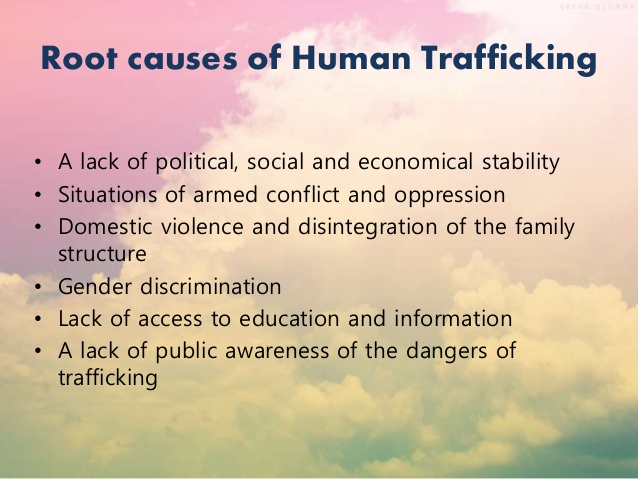
SOLUTIONS TO HUMAN TRAFFICKING
- Government actions
- Activities of religious bodies
- Provision of employment
- Non-governmental organizations such as who
- Economic stability
- Adequate punishment for traffickers
- Awareness programmes
- Strict immigration policies
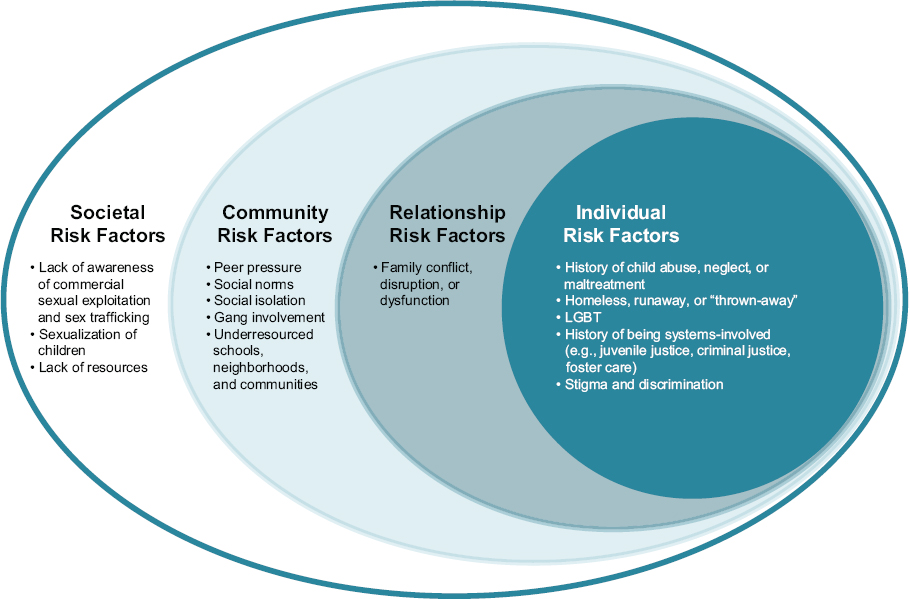

EVALUATION:
1. Mention two (2) health implications of human trafficking
2. State five possible solutions to human trafficking.
ASSIGNMENT
Objective:
1. Human trafficking denotes…………. (a) movement (b) exploitation (c) transferring (d) none of the above.
2. Which of these is not among the causes of human trafficking? (a) slavery (b) forced labour (c) school (d) beggars.
3. The following are groups of human trafficking victims except ………………..(a) as a bride (b) forced labour in factories (c) house keeper (d) none of the above.
Essay:
Suggest three solutions to human trafficking.
TOPIC: HUMAN TRAFFICKING
CONTENT: (1) Meaning of Human Trafficking and Groups of Human Trafficking Victims
(3) Health Implications of Human Trafficking
(4) Solutions of Human Trafficking.
MEANING OF HUMAN TRAFFICKING
Human trafficking is the recruitment, transportation, harbouring, or receipt of people for the purpose of slavery, forced labour and servitude.
Causes of Human Trafficking
- Social discrimination
- Political instability
- Lack of employment opportunities
- Grouping deprivation and marginalization of the poor
- Corruption in government
- Profitability
- Economic disparities
- Insufficient penalty against traffickers
- Regional inbalances
- Armed conflict

GROUPS OF HUMAN TRAFFICKING VICTIMS
- As a bride
- In the sex industry
- Domestic servitude e.g. housekeeper or nanny
- Of organ
- Forced labour in factories or restaurants


EVALUATION:
1. Explain what is meant by human Trafficking
2. Mention five causes of human trafficking
LESSON 8
HEALTH IMPLICATIONS OF HUMAN TRAFFICKING
- Human trafficking results to physical and psychological abuse
- Human trafficking results to physical and psychological health problems for the victim
- Malnourishment, bruises and decayed teeth
- Infectious diseases
- Undetected or untreated diseases e.g. cancer
- Sexually transmitted diseases e.g. hiv/aids
- Unplanned pregnancy
- Depression
- Back pains
- Stress related disorder
- Death
- Phobias and panic attacks


SOLUTIONS TO HUMAN TRAFFICKING
- Government actions
- Activities of religious bodies
- Provision of employment
- Non-governmental organizations such as who
- Economic stability
- Adequate punishment for traffickers
- Awareness programmes
- Strict immigration policies


EVALUATION:
1. Mention two (2) health implications of human trafficking
2. State five possible solutions to human trafficking.
ASSIGNMENT
Objective:
1. Human trafficking denotes…………. (a) movement (b) exploitation (c) transferring (d) none of the above.
2. Which of these is not among the causes of human trafficking? (a) slavery (b) forced labour (c) school (d) beggars.
3. The following are groups of human trafficking victims except ………………..(a) as a bride (b) forced labour in factories (c) house keeper (d) none of the above.
Essay:
Suggest three solutions to human trafficking.
WEEK 6
LESSON 9
TOPIC: Sports laws
CONTENTS:
1. Definition of Terms
DEFINITIONS OF TERMS
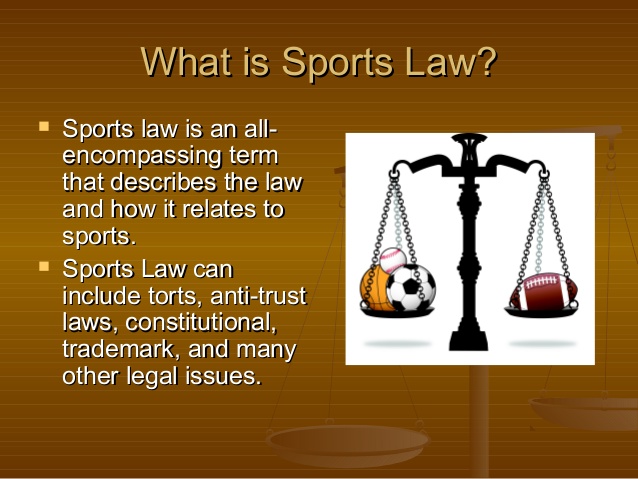
(a) TORT: Is defined as a legal wrong resulting in direct or indirect injury to another individual or to property. A tortuous act is a wrongful act and damages can be claimed through court action.
(b) NEGLIGENCE: is a legal concept in the common legal system usually used to achieve compensation for injuries (not accidents).
(c) LEGAL LIABILITY: Legal means connected with, in accordance with, authorized or required by law. Liability means the state of being liable, that is responsible according to law. The issue at stake is between the physical education teacher, the child, the parent and the law court. The law is at middle to mediate in case of anyone while performance falls short of expectation.
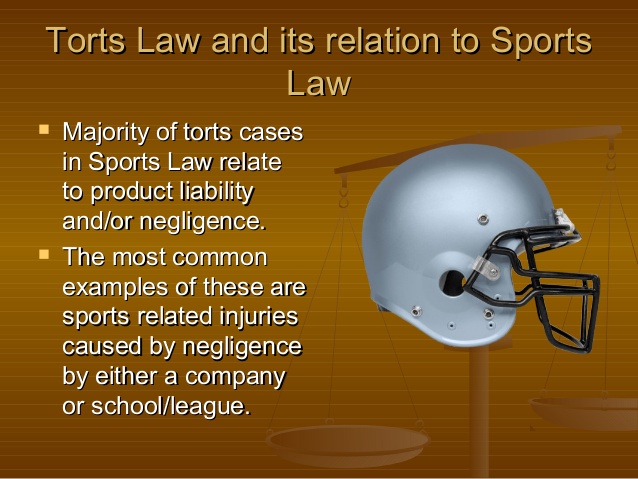
(d) ASSAULT IN SPORTS: it occurs when a person commits the offence of assault to an opponent or official. The following therefore constitutes assault in sports;
-purposely causing reasonable apprehension of bodily injury in sports
-knowingly making physical contact of an insulting or provoking nature with an official
-purposely causing bodily injury to an official
-negligently causing bodily injury to an official with a weapon

EVALUATION:
(a) Explain assault in sports
(b) What do you understand by legal liability in sports laws.
ASSIGNMENT: (Reading Assignment). Essentials of PHE for JSS Book 2 by Akinyeye S.E. PP. 107 -109.
TOPIC: Sports laws
CONTENTS:
1. Definition of Terms
DEFINITIONS OF TERMS

(a) TORT: Is defined as a legal wrong resulting in direct or indirect injury to another individual or to property. A tortuous act is a wrongful act and damages can be claimed through court action.
(b) NEGLIGENCE: is a legal concept in the common legal system usually used to achieve compensation for injuries (not accidents).
(c) LEGAL LIABILITY: Legal means connected with, in accordance with, authorized or required by law. Liability means the state of being liable, that is responsible according to law. The issue at stake is between the physical education teacher, the child, the parent and the law court. The law is at middle to mediate in case of anyone while performance falls short of expectation.

(d) ASSAULT IN SPORTS: it occurs when a person commits the offence of assault to an opponent or official. The following therefore constitutes assault in sports;
-purposely causing reasonable apprehension of bodily injury in sports
-knowingly making physical contact of an insulting or provoking nature with an official
-purposely causing bodily injury to an official
-negligently causing bodily injury to an official with a weapon

EVALUATION:
(a) Explain assault in sports
(b) What do you understand by legal liability in sports laws.
ASSIGNMENT: (Reading Assignment). Essentials of PHE for JSS Book 2 by Akinyeye S.E. PP. 107 -109.
WEEK 7
LESSON 10
TOPICS: Sports and society
CONTENTS:
(a)Introduction
(b)Values/functions of sports in the society
(c) Management of sports (Sports and social control)
SPORTS
Sport has been identified as part of the society in the sense that it provides opportunity for interaction with many social institutions. Sport plays a very vital role in the society. Sport has become a major part of modern society with influence being felt in all area of life to the extent that it has become a cohesive force and symbol of national unity. Most governments in the world seek legitimacy through sport, this accounts for the reason why extensive support is given to sport by many governments.

SOCIETY
Society can be defined as a group of or a nation living together in an organized community. An individual is in communication or making contacts with others.
SOCIOLOGY OF SPORTS
Sociology of sport can be defined as the application of the social science mode of enquiry to the socio-cultural characteristics of sports. This means the application of the findings of sociology to sport. Sociology of sport also deals with those social organizations and institutions that are involved in the provision of sports experience in the society.
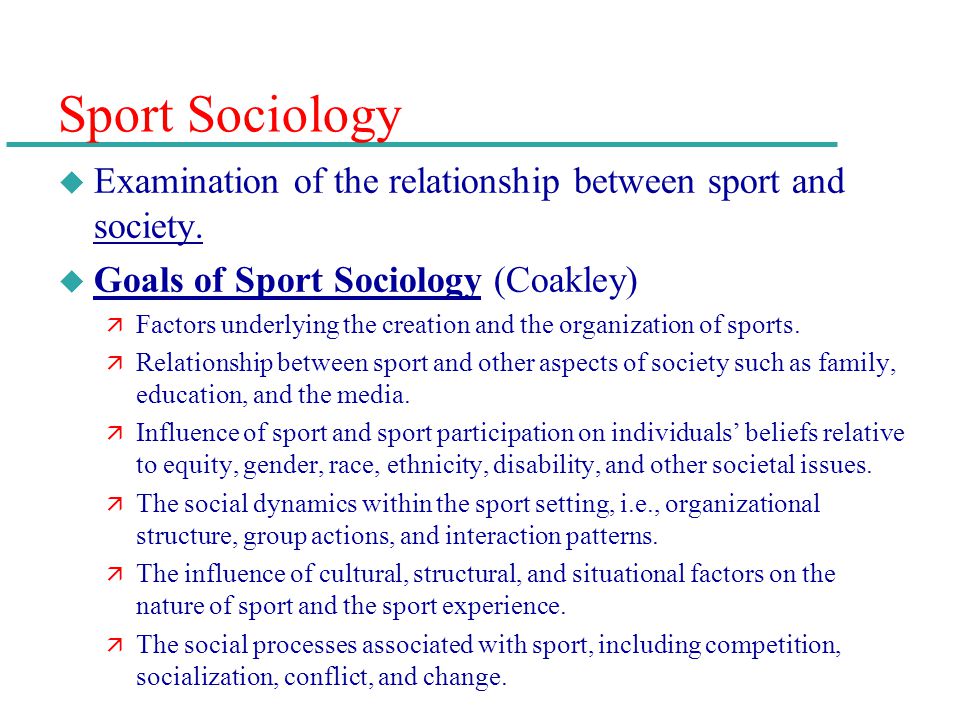
VALUES/FUNCTIONS OF SPORTS IN THE SOCIETY
The benefits of sport to the society according to Unified (1986) are numerous they include the following among others
1. It is used to reduce tension
2. It is used to divert aggressive behavior to an object instead of towards a friend or fellow man
3. It is used as a desired to compete with others and defend oneself, tribe and country
4. The martial arts or combative sports like karate, judo, wrestling, and boxing are used to avoid defeat and to subdue opponents/attackers.
5. It is used to create excitement, amusement, fun, enjoyment, strength and physical fitness.
6. It is used for both economic and political gains.
7. Countries use sport as a legitimate instrument of foreign policy and a medium of showing country’s mood towards another.
8. Victory in sports has some nation impact like prestige, enhanced status and respect.
9. Limelight is brought to any country that records a spectacular victory at an international competition.
10. It serves as a cohesive agent to bring about unity and national awareness.
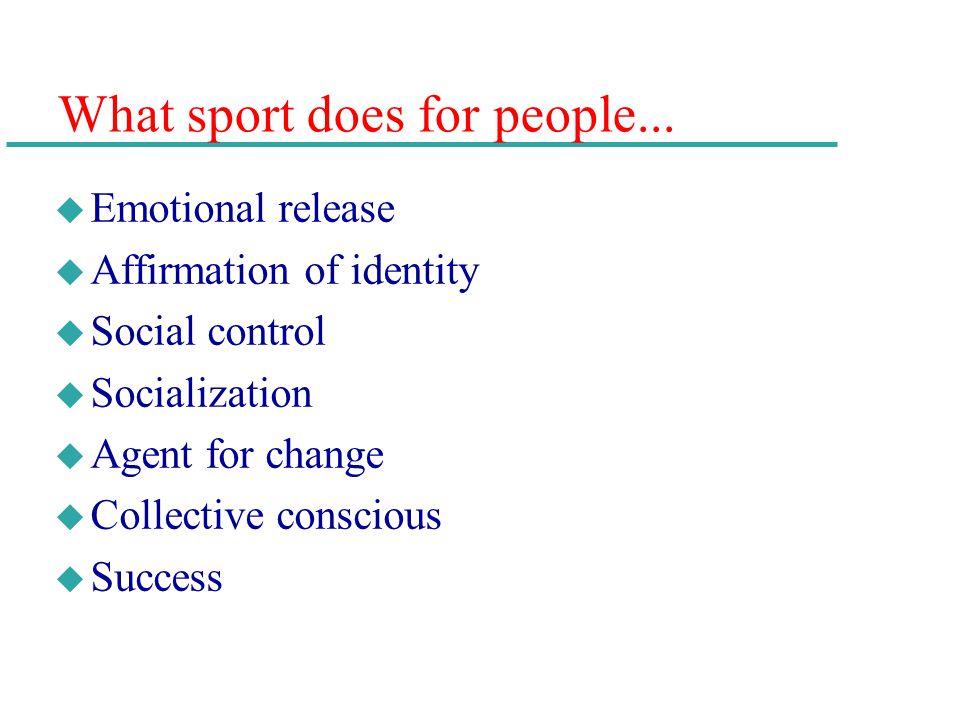
SPORTS AND SOCIAL CONTROL
According to 0nifade (1986), Social control is a means for promoting conformity with societal rules and regulations. Sport as a social control can either be internal or external. As an internal social control, sport would make it possible for individuals to realize that some behaviors are wrong and unacceptable in the society while as an external social control, sport would provide the opportunity for punishments or rewards designed to control behavior, when individuals exhibit acceptable behaviors, they become part of them and these behaviors are carried to other areas of life in the society, thus becoming a character.

SPORT AND CHARACTER BUILDING
Character building can be explained as the acquisition and acceptance of behaviours and principles of life which can serve as a carry-over value to the larger society. In building character through sport, an individual is expected to behave in an orderly and predictable manner during and after participation in sports. Sport as a social control ensures that the norms and values of the society are followed and when they are not followed, the individual concerned is regarded as a deviant.

EVALUATION:
(1) What is Social Control?
(2) Name five (5) functions of sports to the modern day society.
ASSIGNMENTS:
1. Sport has been identified as part of the ………. (a) society (b) nation (c) tax revenue (d) all of the above
2. ………… is the study of the nature and growth of human society (a) society (b) ecology (c) sociology (d) all of the above
3. Which of the following are function of sport in the society……….. (a) it is used to reduce tension (b) it is used to reduce aggressive behaviour (c) it is used to create excitement, amusement and fun.
4. ……… is used to create, excitement, amusement, fun, strength and physical fitness (a) fight (b) war (c) trafficking (d) sport
ESSAY
List the values and functions of sports in the society.
(i) …………………… (ii)……………… (iii)……………….(iv)…………………
TOPICS: Sports and society
CONTENTS:
(a)Introduction
(b)Values/functions of sports in the society
(c) Management of sports (Sports and social control)
SPORTS
Sport has been identified as part of the society in the sense that it provides opportunity for interaction with many social institutions. Sport plays a very vital role in the society. Sport has become a major part of modern society with influence being felt in all area of life to the extent that it has become a cohesive force and symbol of national unity. Most governments in the world seek legitimacy through sport, this accounts for the reason why extensive support is given to sport by many governments.

SOCIETY
Society can be defined as a group of or a nation living together in an organized community. An individual is in communication or making contacts with others.
SOCIOLOGY OF SPORTS
Sociology of sport can be defined as the application of the social science mode of enquiry to the socio-cultural characteristics of sports. This means the application of the findings of sociology to sport. Sociology of sport also deals with those social organizations and institutions that are involved in the provision of sports experience in the society.

VALUES/FUNCTIONS OF SPORTS IN THE SOCIETY
The benefits of sport to the society according to Unified (1986) are numerous they include the following among others
1. It is used to reduce tension
2. It is used to divert aggressive behavior to an object instead of towards a friend or fellow man
3. It is used as a desired to compete with others and defend oneself, tribe and country
4. The martial arts or combative sports like karate, judo, wrestling, and boxing are used to avoid defeat and to subdue opponents/attackers.
5. It is used to create excitement, amusement, fun, enjoyment, strength and physical fitness.
6. It is used for both economic and political gains.
7. Countries use sport as a legitimate instrument of foreign policy and a medium of showing country’s mood towards another.
8. Victory in sports has some nation impact like prestige, enhanced status and respect.
9. Limelight is brought to any country that records a spectacular victory at an international competition.
10. It serves as a cohesive agent to bring about unity and national awareness.

SPORTS AND SOCIAL CONTROL
According to 0nifade (1986), Social control is a means for promoting conformity with societal rules and regulations. Sport as a social control can either be internal or external. As an internal social control, sport would make it possible for individuals to realize that some behaviors are wrong and unacceptable in the society while as an external social control, sport would provide the opportunity for punishments or rewards designed to control behavior, when individuals exhibit acceptable behaviors, they become part of them and these behaviors are carried to other areas of life in the society, thus becoming a character.

SPORT AND CHARACTER BUILDING
Character building can be explained as the acquisition and acceptance of behaviours and principles of life which can serve as a carry-over value to the larger society. In building character through sport, an individual is expected to behave in an orderly and predictable manner during and after participation in sports. Sport as a social control ensures that the norms and values of the society are followed and when they are not followed, the individual concerned is regarded as a deviant.

EVALUATION:
(1) What is Social Control?
(2) Name five (5) functions of sports to the modern day society.
ASSIGNMENTS:
1. Sport has been identified as part of the ………. (a) society (b) nation (c) tax revenue (d) all of the above
2. ………… is the study of the nature and growth of human society (a) society (b) ecology (c) sociology (d) all of the above
3. Which of the following are function of sport in the society……….. (a) it is used to reduce tension (b) it is used to reduce aggressive behaviour (c) it is used to create excitement, amusement and fun.
4. ……… is used to create, excitement, amusement, fun, strength and physical fitness (a) fight (b) war (c) trafficking (d) sport
ESSAY
List the values and functions of sports in the society.
(i) …………………… (ii)……………… (iii)……………….(iv)…………………
WEEK 8
LESSON 11
TOPIC: CAREER AND BRANCHES OF PHE
CONTENTS
1. Definition of Career
2. Branches of PHE
3. Choosing a Career.
CAREER
A career is progress and actions taken by a person throughout a lifetime, especially related to that person occupation.

BRANCHES OF P.H.E.
1. Sports psychology
2. Sports science
3. Sports management
4. Sports medicine
5. Sports marketing
6. Recreational management
7. Sociology of sports
SPORT PSYCHOLOGY: is the study of a people’s behaviour in sport.
SPORT SCIENCE: is a discipline that studies the application of scientific principles and techniques with the aim of improving sporting performance.
SPORT MANAGEMENT: is a field of education and vocation concerning the business aspect of sport.
SPORT MEDICINE: medical specialty concerned with the diagnosis, treatment, rehabilitation, and prevention of athletic injuries and with the effects of exercise on the human body.
SPORT MARKETING: refer to the specific application of marketing principles and processes to sport products e.g. teams, leagues, events etc.
RECREATION MANAGEMENT: is the process of profession of maintaining and administering the physical facilities and personnel involved in leisure-based recreational activities.
SOCIOLOGY OF SPORT: alternately referred to as sport sociology is an area of sociology that focuses on sport as a social phenomenon and on the social and cultural patterns, and organizations or groups engaged in sport.
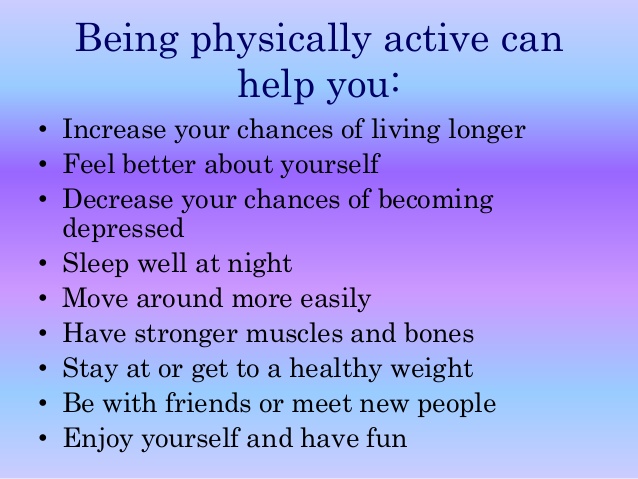
HOW TO CHOOSE A CAREER
Where do my interests lie?
What do I do well and enjoy?
What kind of personality do I have?
What’s really important to me?
What are my values?
What are my natural talents?
Others are:
Aptitudes, skills, interests, personal style, values, family and personal needs, physical need, goals, financial needs.
Career opportunity in PHE includes:
-coaching
-physical trainer
-sport psychologist
-sport marketer
-exercise therapist
-sport administrator
-health journalist
-community development worker
-teaching
-consultant
-grounds men
-IEC developers.
EVALUATION:
1. Explain career
2. List five (5) branches of PHE
3. Mention five (5) career opportunities in PHE.
TOPIC: CAREER AND BRANCHES OF PHE
CONTENTS
1. Definition of Career
2. Branches of PHE
3. Choosing a Career.
CAREER
A career is progress and actions taken by a person throughout a lifetime, especially related to that person occupation.

BRANCHES OF P.H.E.
1. Sports psychology
2. Sports science
3. Sports management
4. Sports medicine
5. Sports marketing
6. Recreational management
7. Sociology of sports
SPORT PSYCHOLOGY: is the study of a people’s behaviour in sport.
SPORT SCIENCE: is a discipline that studies the application of scientific principles and techniques with the aim of improving sporting performance.
SPORT MANAGEMENT: is a field of education and vocation concerning the business aspect of sport.
SPORT MEDICINE: medical specialty concerned with the diagnosis, treatment, rehabilitation, and prevention of athletic injuries and with the effects of exercise on the human body.
SPORT MARKETING: refer to the specific application of marketing principles and processes to sport products e.g. teams, leagues, events etc.
RECREATION MANAGEMENT: is the process of profession of maintaining and administering the physical facilities and personnel involved in leisure-based recreational activities.
SOCIOLOGY OF SPORT: alternately referred to as sport sociology is an area of sociology that focuses on sport as a social phenomenon and on the social and cultural patterns, and organizations or groups engaged in sport.

HOW TO CHOOSE A CAREER
Where do my interests lie?
What do I do well and enjoy?
What kind of personality do I have?
What’s really important to me?
What are my values?
What are my natural talents?
Others are:
Aptitudes, skills, interests, personal style, values, family and personal needs, physical need, goals, financial needs.
Career opportunity in PHE includes:
-coaching
-physical trainer
-sport psychologist
-sport marketer
-exercise therapist
-sport administrator
-health journalist
-community development worker
-teaching
-consultant
-grounds men
-IEC developers.
EVALUATION:
1. Explain career
2. List five (5) branches of PHE
3. Mention five (5) career opportunities in PHE.